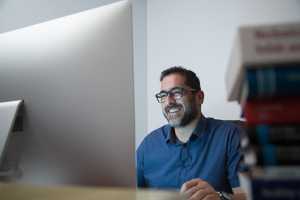Deep within a UH computer, models being built by Theocharis Baxevanis, assistant professor of mechanical engineering, just may cause a sea change in the aerospace industry. The hydro-mechanical system actuator, like an on/off switch, that controls the wing flaps (you see them coming up as a plane is landing) could be replaced with a new solid-state actuator made of a new High Temperature Shape Memory Alloy (HTSMA) that is lighter and more cost efficient.
“I’m trying to design the material that will make this new technology available for the aerospace industry as soon as possible,” said Baxevanis.
The National Science Foundation (NSF) awarded him and his co-PIs at Texas A&M University $1.5M to carry out the work. The grant comes through the NSF’s Designing Materials to Revolutionize and Engineer our Future (DMREF) program, in support of the multi-agency federal Materials Genome Initiative (MGI), seeking to target one of the primary MGI goals — to halve the current time and cost for transitioning breakthroughs from the laboratory to the marketplace — a process that can take as long as two decades.
New to the UH Cullen College, Baxevanis brought his portion of the grant, Accelerating the Development of Phase Transforming Heterogeneous Materials: Application to High Temperature Shape Memory Alloys, to Houston.
Back to those wing flaps
Baxevanis concentrates on HTSMAs which are alloys (a mixture of metals) that can change shape and operate at high temperatures providing high power density.
Currently in the aerospace industry, conventional actuators control airplanes’ wing flaps. Though perfectly safe, the wing weight could be lightened if the actuators are made out of new HTSMA materials, and Baxevanis is set on designing the HTSMA to do just that.
“We would like to replace the conventional actuators in the aerospace industry with single-piece, compact actuators from high temperature shape memory alloys,” said Baxevanis. “They perform the functions of several materials and parts simultaneously, thus simplifying the device design, having fewer parts to break or wear down during the service of the plane, so they will save the industry money and decrease the overall weight of the plane and the drag on it.”
Putting the pedal to the metal
But 20 years is too much time for the entire process of bringing the lightweight actuator to market. The project attempts to accelerate the development and application of HTSMA–actuators by combining ideas from informatics and design with experimental and computational materials science.
“The basic idea is to develop a framework that will allow the design of a material equipped with tailored properties by conducting an optimum number of physical experiments, which are costly and time consuming,” said Baxevanis. For optimizing the required number of physical experiments to actually take to the lab, he conducts numerical experiments – or “fictitious experiments,” as he calls them.
“We test hypothetical materials with computer models,” he said. “The simulations guide targeted physical experiments that in turn allow for the refinement of the models and point us towards where we should look next, effectively reducing the required number of physical experiments before coming up with the material that we are looking for.”
Research taking flight
Once their work is completed, Baxevanis and his collaborators would like anyone in the world to be able to pick up on their research and continue creating new phase transforming materials quicker by learning from their experience.
“We want to create a database and a framework available for other researchers designing phase transforming materials for specific application requirements,” he said.
That way, when Baxevanis flies on from this project to the next, his research will continue to soar.
